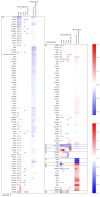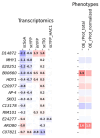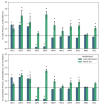An Interplay between Transcription Factors and Recombinant Protein Synthesis in Yarrowia lipolytica at Transcriptional and Functional Levels-The Global View
- PMID: 39273402
- PMCID: PMC11395014
- DOI: 10.3390/ijms25179450
An Interplay between Transcription Factors and Recombinant Protein Synthesis in Yarrowia lipolytica at Transcriptional and Functional Levels-The Global View
Abstract
Transcriptional regulatory networks (TRNs) associated with recombinant protein (rProt) synthesis in Yarrowia lipolytica are still under-described. Yet, it is foreseen that skillful manipulation with TRNs would enable global fine-tuning of the host strain's metabolism towards a high-level-producing phenotype. Our previous studies investigated the transcriptomes of Y. lipolytica strains overproducing biochemically different rProts and the functional impact of transcription factors (TFs) overexpression (OE) on rProt synthesis capacity in this species. Hence, much knowledge has been accumulated and deposited in public repositories. In this study, we combined both biological datasets and enriched them with further experimental data to investigate an interplay between TFs and rProts synthesis in Y. lipolytica at transcriptional and functional levels. Technically, the RNAseq datasets were extracted and re-analyzed for the TFs' expression profiles. Of the 140 TFs in Y. lipolytica, 87 TF-encoding genes were significantly deregulated in at least one of the strains. The expression profiles were juxtaposed against the rProt amounts from 125 strains co-overexpressing TF and rProt. In addition, several strains bearing knock-outs (KOs) in the TF loci were analyzed to get more insight into their actual involvement in rProt synthesis. Different profiles of the TFs' transcriptional deregulation and the impact of their OE or KO on rProts synthesis were observed, and new engineering targets were pointed.
Keywords: heterologous protein; omics data; protein production; transcriptional regulation; yeast.
Conflict of interest statement
The authors declare no conflicts of interest.
Figures





Similar articles
-
Global transcription machinery engineering in Yarrowia lipolytica.FEMS Yeast Res. 2025 Jan 30;25:foaf023. doi: 10.1093/femsyr/foaf023. FEMS Yeast Res. 2025. PMID: 40338609 Free PMC article. Review.
-
Transcription factors enhancing synthesis of recombinant proteins and resistance to stress in Yarrowia lipolytica.Appl Microbiol Biotechnol. 2023 Aug;107(15):4853-4871. doi: 10.1007/s00253-023-12607-z. Epub 2023 Jun 15. Appl Microbiol Biotechnol. 2023. PMID: 37318637 Free PMC article.
-
Impact of oxygen availability on heterologous geneexpression and polypeptide secretion dynamics in Yarrowia lipolytica-based protein production platforms.Yeast. 2020 Sep;37(9-10):559-568. doi: 10.1002/yea.3499. Epub 2020 Jun 26. Yeast. 2020. PMID: 32445214
-
High-throughput metabolic engineering of Yarrowia lipolytica through gene expression tuning.Proc Natl Acad Sci U S A. 2025 Jun 10;122(23):e2426686122. doi: 10.1073/pnas.2426686122. Epub 2025 Jun 3. Proc Natl Acad Sci U S A. 2025. PMID: 40460129 Free PMC article.
-
Yarrowia lipolytica: recent achievements in heterologous protein expression and pathway engineering.Appl Microbiol Biotechnol. 2015 Jun;99(11):4559-77. doi: 10.1007/s00253-015-6624-z. Epub 2015 May 7. Appl Microbiol Biotechnol. 2015. PMID: 25947247 Review.
Cited by
-
Global transcription machinery engineering in Yarrowia lipolytica.FEMS Yeast Res. 2025 Jan 30;25:foaf023. doi: 10.1093/femsyr/foaf023. FEMS Yeast Res. 2025. PMID: 40338609 Free PMC article. Review.
-
New Yarrowia lipolytica chassis strains for industrial enzyme production.Microb Cell Fact. 2025 Jul 10;24(1):164. doi: 10.1186/s12934-025-02787-w. Microb Cell Fact. 2025. PMID: 40640804 Free PMC article.
References
MeSH terms
Substances
Grants and funding
LinkOut - more resources
Full Text Sources
Research Materials
Miscellaneous

